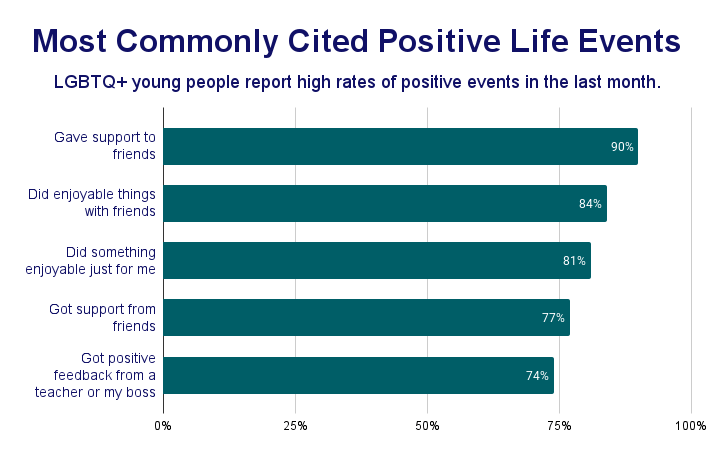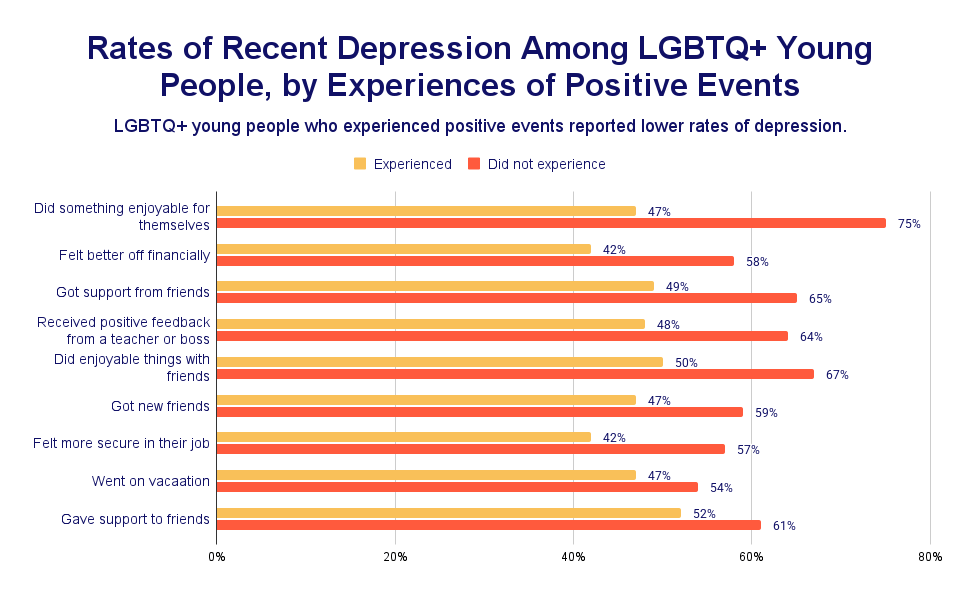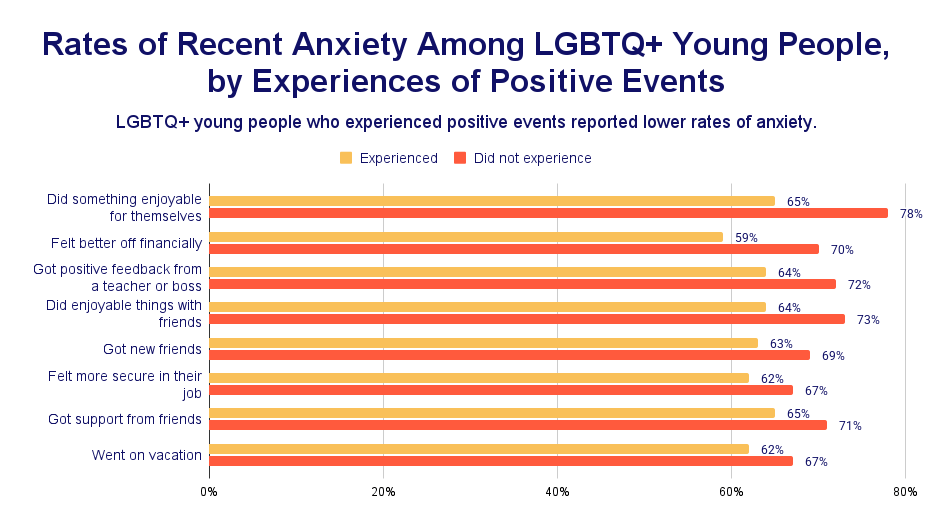Youth's Lives Every Day
Key Findings
- High rates of positive events: A large majority of LGBTQ+ young people reported experiencing positive events in the past month, including:
- Giving support to friends (90%)
- Doing enjoyable activities with friends (84%)
- Doing something enjoyable just for themselves (81%)
- Positive events were associated with lower depression: Several specific positive events were associated with significantly lower rates of recent depressive symptoms, such as:
- Doing something enjoyable for oneself
- Feeling better off financially
- Getting support from friends
- Positive events were associated with lower anxiety: Several positive events were associated with significantly lower rates of recent symptoms of anxiety, such as:
- Doing enjoyable things with friends
- Making new friends
- Feeling more secure in their job
The 2025 U.S. National Survey on the Mental Health of LGBTQ+ Young People is now open!
If you’re LGBTQ+ and 13–24, we would love to hear from you.
Background
There is a firmly established link between negative events – such as receiving negative feedback or witnessing violence – and poorer mental health outcomes, including higher rates of depression, anxiety, and suicidal behaviors, among both adults and young people.1-4 However, there is less data available on the potential impact of positive events on mental health. Previous research has found that positive events, such as going on vacation or doing something enjoyable with friends, are associated with lower rates of depressive symptoms among adults.5-6 Although positive events, especially those involving social relationships (e.g., doing activities with friends) or those independent of a person’s behavior (e.g., experiencing an unexpected financial gain), are associated with increased positive affect in young people,7 research on positive events and depression among adolescents has not documented significant relationships.3 Furthermore, there is little to no research on the relationship between positive events and mental health for LGBTQ+ youth specifically, a community who reports higher rates of poor mental health than their non-LGBTQ+ peers.8,9 Using data from The Trevor Project’s 2024 U.S. National Survey on the Mental Health of LGBTQ+ Young People, this brief examines the relationship between self-reported positive events in the last month and rates of recent depression and anxiety among 18,663 LGBTQ+ youth ages 13 to 24.
Results
LGBTQ+ young people were asked whether they had experienced any of 15 specific positive life events in the past month (see Methods section for a complete list). A large majority of LGBTQ+ young people reported experiencing positive events in the past month. The five most commonly reported positive events they had experienced were: giving support to friends (90%), doing enjoyable things with friends (84%), doing something enjoyable just for themselves (81%), receiving support from friends (77%), and receiving positive feedback from a teacher or boss (74%). There were no significant differences in these five most commonly cited positive events by gender identity or race/ethnicity.

Nine of the 15 queried positive events were associated with significantly lower rates of recent depressive symptoms (p<.001).

Logistic regression analyses showed that these relationships were significant even when controlling for age, census region, socioeconomic status, sexual orientation, gender identity, and race. The remaining six positive events were not associated with recent depression at the p <0.001 level for both bivariate and logistic regression analyses.
Eight of the 15 queried positive events were associated with significantly lower rates of recent symptoms of anxiety (p<.001).

Logistic regression analyses showed that these relationships were significant even when controlling for age, census region, socioeconomic status, sexual orientation, gender identity, and race. The remaining seven positive life events did not have significant relationships with recent anxiety at the p <0.001 level for both bivariate and logistic regression analyses.
Looking Ahead
These findings highlight the relationship between positive events and the mental health of LGBTQ+ young people. LGBTQ+ young people reported high rates of having experienced positive events in the last month, such as giving support to friends (90%), doing enjoyable activities with friends (84%), or doing something enjoyable just for themselves (81%). There were no differences in rates of reported positive events between transgender and nonbinary young people and their cisgender peers, nor LGBTQ+ youth of color and their White LGBTQ+ peers. A number of specific positive events were associated with significantly lower rates of reported symptoms of depression in the last two weeks among LGBTQ+ youth, including doing something for themselves, feeling better off financially, and getting support from friends. These findings align with previous research documenting relationships between positive events and lower rates of depression among adults.5,6 Several of the queried positive events were associated with lower rates of reported symptoms of anxiety in the last two weeks among LGBTQ+ youth, including doing something enjoyable for themselves, feeling better off financially, and getting positive feedback from a teacher or boss.
These findings highlight the importance of relationships, self-care, and economic security in LGBTQ+ young people’s lives and mental health. A number of the positive events associated with lower rates of depression and anxiety involved doing enjoyable things or exchanging support with friends. Receiving positive feedback from a teacher or boss was also associated with lower rates of both depression and anxiety. Doing enjoyable things for oneself, or engaging in intentional self-care, was also associated with lower rates of both depression and anxiety. Finally, these findings illuminate the possible impact of having one’s economic needs met on mental health among LGBTQ+ young people: being better off financially or feeling more secure in a job were both associated with lower rates of both depression and anxiety, which aligns with other scholarship on economic indicators and mental health.10 Advocates working to improve the mental health of LGBTQ+ young people should consider ways to increase LGBTQ+ young people’s access to supportive relationships and spaces, as well as economic resources.
There are some limitations to using cross-sectional survey methods to examine the relationship between life events and mental health. We do not know when the positive life event may have occurred in the last month and cannot establish a temporal relationship between the life event and either higher or lower levels of mental health symptoms. Future research should consider longitudinal methods in order to establish the temporal direction between positive events and mental health outcomes.
The Trevor Project is committed to supporting LGBTQ+ young people’ access to positive events and good mental health through crisis intervention, research, and advocacy initiatives. Our 24/7 crisis services—available by phone, chat, and text—ensure that LGBTQ+ youth can connect with trained counselors whenever they need support. We are also dedicated to improving LGBTQ+ young peoples’ access to supportive relationships and institutions. TrevorSpace, our dedicated social networking platform, provides a safe and affirming space for LGBTQ+ young people to connect with supportive peers, helping to reduce isolation and promote community support. Our education team equips adults with the tools needed to support LGBTQ+ youth across diverse identities and experiences. Meanwhile, our advocacy team works at the state and federal level to promote access to inclusive, affirming environments and mental health care. We remain committed to publishing research that explores the nuanced mental health experiences of LGBTQ+ youth, especially those impacted by structural inequities, to drive informed policy and life-saving intervention. Additionally, The Trevor Project provides resources for both LGBTQ+ young people and their allies, such as LGBTQ+ Mental Health Resources.
Data Tables
Experiences of Positive Events and Their Associations with Recent Depression and Anxiety Among LGBTQ+ Young People

Methods
References
Recommended Citation
The Trevor Project (2025). Positive Events and Mental Health Among LGBTQ+ Young People. https://doi.org/10.70226/TDEJ1121
For more information please contact: Research@TheTrevorProject.org
© The Trevor Project 2025